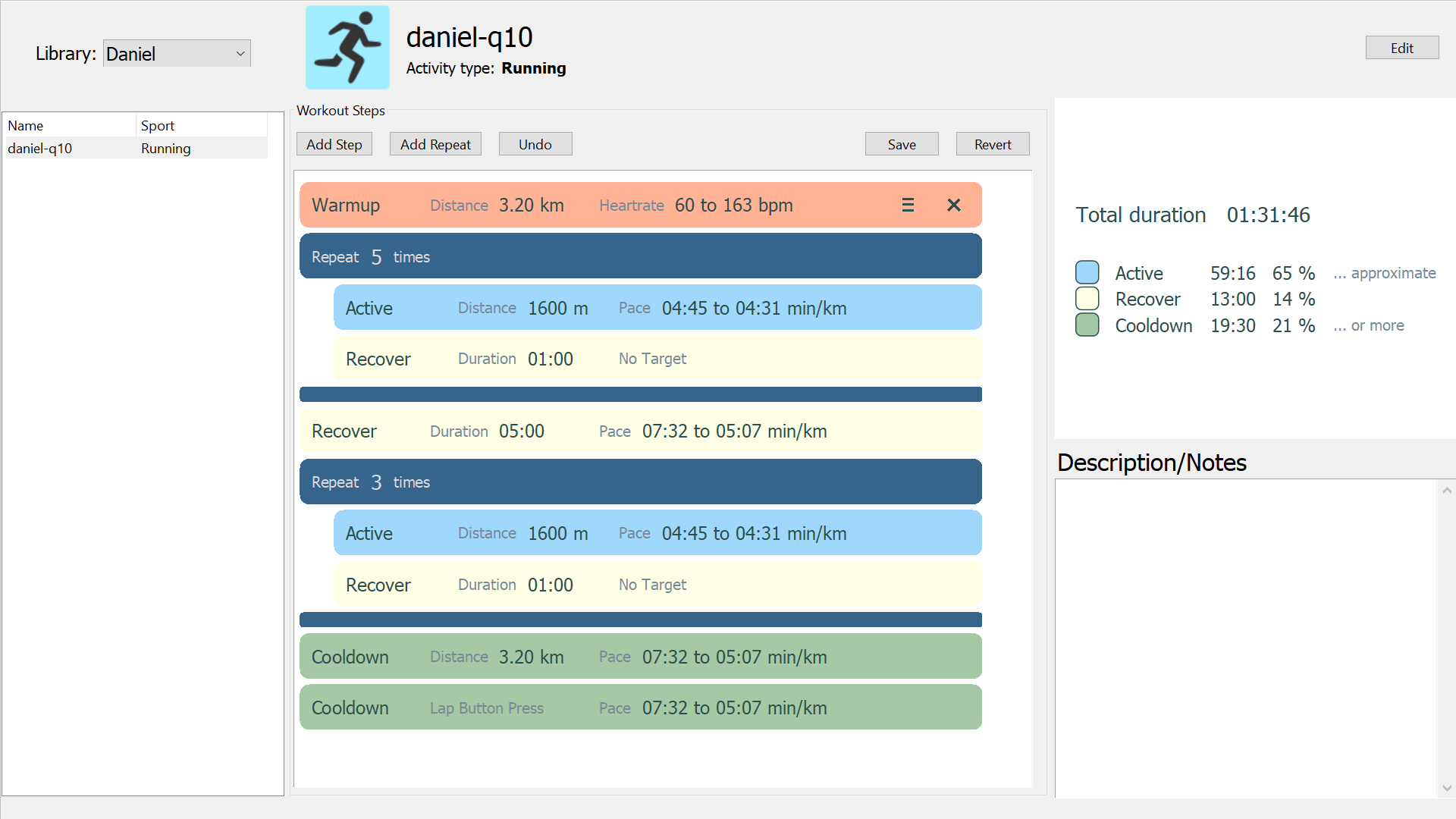Running and Cycling Workout Editor
A Garmin fitness device can use workouts during a bike or run activity: they are a collection of steps with a duration and intensity (such as heart rate, pace or power). While running or biking, the device keeps track of the duration and will sound an alarm if the intensity is too high or too low. Workouts can be created on the Garmin Connect website, but I decided to write my own application for creating workouts.
Garmin devices use the “Fitness Interchange Format” (files with the “FIT” extension) for any data that is transferred to and from the device. The data received from the device is most often activity or session data, so FIT files are more commonly associated with fitness activities. However, FIT files are used for other things as well: in particular, device settings and workouts can be sent to the device as a FIT file. “Sending to the device” in this case means simply copying the file: when the Garmin device is connected to the computer via USB, it shows up as a normal USB Drive and files can be copied on the “NewFiles” folder on that device.
A programmers workout editor
Relatively early on in the ActivityLog2 project, I added support for writing out FIT files, especially workouts and settings. Since I am a programmer, I just wrote a small library which allowed to write workouts something like this:
1 2 3 4 5 6 7 8 9 10 11 12 13 14 15 16 17 18 19 20 21 22 |
(define (hr/warmup) (hr/bpm 60 163)) (define (pace/hard) (speed (pace 4 29) (pace 4 0))) (define (pace/easy) (speed (pace 7 32) (pace 5 7))) (define (pace/tempo) (speed (pace 4 45) (pace 4 31))) (define (wk-daniel-q10) (define wk (new fit-workout-file% [name "daniel-q9"] [sport 1])) ((workout (step (miles 2) (hr/warmup) warmup) (repeat 4 (step (miles 1) (pace/tempo) active) (step (minutes 1) (no-target) recover)) (step (minutes 5) (pace/easy) recover) (repeat 3 (step (miles 1) (pace/tempo) active) (step (minutes 1) (no-target) recover)) (step (miles 2) (pace/easy) cooldown) (step (lap-button) (pace/easy) cooldown)) wk) (send wk get-fit-data)) |
To someone familiar with writing (or reading) code it should not be too difficult to determine that the code above defines the following workout:
- A warmup step, 2 miles long with a “hr/warmup” heart rate (this is defined above as being a Heart Rate between 60 and 163 BPM
- A repeat (four times) of: 1 mile at tempo pace (this is defined above as 4:45 to 4:31 min/km followed by 1 minute recovery
- 5 minutes at an easy pace (defined above as 7:32 to 5:07 min/km)
- another repeat (three times) of: 1 mile at tempo pace followed by 1 minute recovery
- 5 minutes cooldown at an easy pace
- another cooldown step which lasts until the “Lap” button is pressed on the watch
As a side note, the code above defines a wk-daniel-q10 function, which, when called, returns a byte string representing the binary FIT workout data. This data can be written to a file and transferred to the device.
This method of writing workouts has the advantage that workouts can be written using text editors, and they are really Racket programs, so one has the full flexibility of a programming language when defining them. The library that is used to write these workouts is about 150 lines of code and I was able to write it in an afternoon.
A GUI workout editor
I have used the above method for writing workouts for the past four years to write workouts for my training needs, but it is not for everyone. After a while I realized that it has some limitations: even as a programmer, when it comes to managing my training, I prefer a GUI approach, with immediate feedback. In particular, I wanted feedback on the estimated duration of the workout, as well as percentage of time spent in “active” vs " recovery". Writing a GUI application is more difficult than a simple library so I kept postponing this project (for comparison, the GUI workout editor is about 3000 lines of code vs about just 150 for the helper library). However, I had some more spare time than usual in the last few weeks, so I decided to try to implement it. The result is here:

The workout editor is not released yet (there are still some bugs that need fixing), so you will need to download the source code and build it.
What it can do now:
- build bike and running workouts based on Heart Rate, Pace or Power
- estimate the duration of a workout, useful if you want your workout to fit in a specified time (e.g. 1 hour), as well as percentage of time spent in warmup/cooldown or active/rest.
- generate FIT workout files which can be used on a Garmin device (other devices might work too.
Plans for the future:
- Since workouts are stored in the database, activities can be linked back to workouts. This would be useful in providing better estimates for workout duration/distance/effort.
- Generate ERG/MRG workout files for use on a bike trainer
- In addition to time estimates, provide plots of estimated W’Bal expenditure and recovery — a Critical Power model can determine if the designed workout is too hard or too easy, which would be really cool.